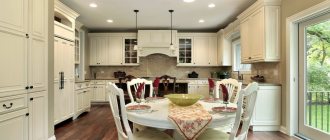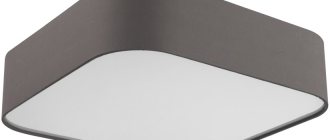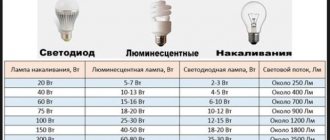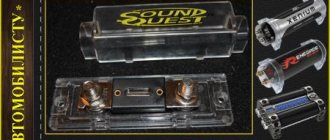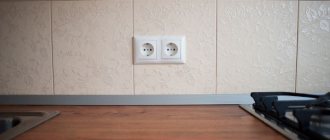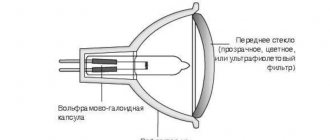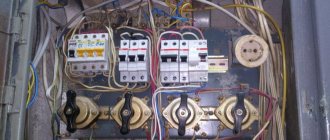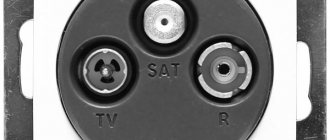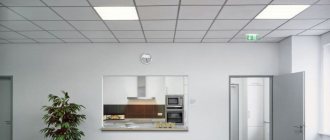Choosing lighting for a stretch ceiling
When starting to design, it is important to determine the current lamp. With proper organization of lighting, the comfort of the room will increase. You need to choose based on the decorative parameters of the room and the amount of natural light.
There are 3 types of chandeliers on the market, which differ in the type of attachment to the ceiling:
- Hanging;
- Built-in;
- Ceiling-mounted.
Suspended ones are attached directly to the ceiling using a hook and a strip. The fixation is reliable, durable, fastening elements are not visible. The disadvantage of the system is that the chandelier is mounted to the bar with screws on top of the canvas. This leads to two disadvantages:
- The fabric may tear due to tension and uneven openings;
- Using incandescent or halogen lamps may cause the plastic to melt.
Hanging chandeliers are rarely used in residential premises, but are popular in cafes, restaurants, and bars. They give a large amount of light and cover huge areas.
Embedded systems are almost invisible, as they merge with the panel. A base is mounted on the ceiling in advance. After installing the ceiling, a hole is made in the fabric. A lamp with special springs is inserted into it. They straighten and tightly fix the body. Additionally, a decorative overlay is placed on top.
Visually, the light source completely merges with the surface. It looks laconic, no screws are used. Suitable for residential buildings, they allow you to zone a room. Spots are mounted in a group so that the light flux is larger. Often equipped with a fluorescent flux regulator.
The invoices got their name due to the specifics of the fastening. They are literally superimposed on the fabric. The type of fastening is similar to the previous type. They do not spoil the design of the room.
They can have a rotating (it is possible to manually adjust the direction of the light) and a non-rotating design.
What are spots
Spots are local lighting devices mounted on a ceiling or wall and consisting of three main units: a base, an articulated bracket and a lamp. A special feature of the spots is the movable design of the bracket, which allows you to direct the light source in the desired direction during operation. These lighting devices probably got their name because the light beam they generate, directed at a plane, creates a spot on it, a point - a “spot” in English.
In addition to movable brackets, spots can be equipped with built-in dimmers - power and lighting brightness regulators. This function is especially attractive in terms of efficiency - you can use such a lamp at full power only when necessary (reading, sewing, etc.), the rest of the time the brightness is manually reduced to the required value.
Varieties
The design of these lamps is universal, and therefore these lighting devices are not classified according to the place of possible installation - the spots can be mounted on both walls and ceilings. Exceptions are models decorated with decorative pendants, which imply only ceiling placement.
Stretch ceiling vinyl cladding is not an obstacle to the installation of spots - if the requirements for the permissible power of the lighting lamps used are met, these lamps are suitable for use in close proximity to PVC film and will effectively decorate an elastic suspended ceiling of both single-level and multi-tiered structures.
Based on the installation method, spots are divided into built-in, suspended, overhead and tensioned.
Recessed lamps, mounted on a supporting base, protrude into the room through holes in the PVC shell only as a decorative shade - the device body with a movable bracket and wiring are hidden behind the canvas.
Suspended (combined) spots are also mounted on a ceiling base, but their mounting method and design resemble a chandelier, but with the option of changing the direction of the light rays. Like chandeliers, lighting fixtures of this type are suspended from the ceiling on a hook through a hole in PVC fabric with a tread ring. The load-bearing ceiling fasteners and wiring remain under the tension shell, and the suspended spot with one or more decorative lampshades remains open to view.
Spots of an overhead structure have significant dimensions and design, which do not allow the fastening part to be hidden under a PVC sheet, therefore they are mounted on top of a stretch ceiling on a frame mounted underneath it to a load-bearing base.
Spots of a tension mounting structure consist of several lighting devices strung on cables stretched across the room. Design in the “techno” style does not suit every room, so the installation of tension spots should fit into the overall style of the interior.
All of the above types of spots are produced both in single and group versions, which allows you to distribute individual lamps on the surface according to a certain pattern, or install a group of reflectors, compactly mounted on a common platform base and consisting of lamps of various types.
The following types of lamps are used in spots under suspended ceilings:
- conventional (incandescent lamps);
- energy saving;
- halogen;
- LED
The use of conventional incandescent lamps (E27 and E14 sockets) in spots is quite widespread. The advantages of these devices are the “warm” color of the lighting, the absence of flicker, which is harmful to vision, and low cost.
But there are also significant disadvantages - incandescent lamps have a low coefficient of conversion of electricity into light, and into heat - high, so there is no need to talk about their efficiency. Accordingly, the presence of intense heat generation limits the power of conventional lamps used in PVC shells - up to 60 W for fabric panels and 40 W for film ones. In addition, the yellow color of the rays of such lighting devices changes the color scheme of the artistic design of stretched canvases, especially blue and blue tones.
Halogen lamps are an improved version of conventional incandescent lamps, divided into low-voltage (12-24 V) and high-voltage (220 V) products. The flask of the device is made of heat-resistant quartz glass and filled with iodine or bromine vapor, which prevents evaporating tungsten particles from settling on its walls and ensures their return to the filament. This allows you to increase the temperature of the coil and achieve the production of light with characteristics close to daylight.
Halogen lamps are economical, but in terms of energy consumption they are almost no different from conventional incandescent lamps. Cost-effectiveness in this case is due to the durability of these devices - 2000-4000 hours, and when using a soft start - 8000-12000 hours.
Halogen lamps have a higher cost.
When installing them, do not touch the flask with bare hands - grease marks on the glass during combustion will shorten the service life of the device.
Dimmers cannot be used on halogen lamps - when the filament heat decreases, the temperature in the bulb will drop and will be insufficient for tungsten to react with the inert gas, it will begin to settle on the walls of the bulb in the form of a silvery coating, and the bulb will burn out after 100-150 hours of operation.
Energy-saving lamps are luminescent devices, the size of which does not allow their use in small, built-in spots. But in suspended, overhead and tension structures, these lamps cope with the assigned tasks quite well. The surface temperature of the bulb of energy-saving devices is not high, and according to the color of the lighting they are divided into “warm” (yellow) and cold (white)”, which makes it possible to take into account the tonality of the artistic design of the stretched fabric.
As for durability, it directly depends on the quality of the device. Lamps from well-known manufacturers have a long service life, but this is inevitably reflected in the price - high-quality energy-saving lamps can be 10 or more times more expensive than conventional incandescent lamps.
LED lamps are modern devices characterized by a high conversion rate of electricity into light with low energy consumption and heat generation. Such lamps are more durable than halogen lamps and are compact; instead of a reflector, they use a lens behind which one powerful or several weaker LEDs are located.
Important! Lamp models with one LED are more durable.
You can get light that is as close as possible to daylight in characteristics using LED lamps from a price range above the average, equipped with modern dimmers - the regulators of older models are not able to reveal the potential of top-end devices.
Based on the voltage of current consumption, spots for a stretch ceiling lighting system are divided into 2 groups: 220 V and 12 V.
Spots designed for 12 V voltage may have a special voltage converter in their design, allowing them to be connected to a household network.
Other 12-volt models require the installation of an individual adapter or a general “rectifier” for the lighting system, which converts 220 V alternating current into 12 V constant frequency current.
Of course, both models using both voltage values have the right to exist. But a 12 V system is still preferable for safety reasons, which comes first.
Advantages and disadvantages
There are disproportionately more arguments in favor of using spots for installing a stretch ceiling lighting system than arguments against their use. Here are the advantages of these lamps:
- ease of installation, making it possible to install it yourself;
- compactness of built-in models with high efficiency;
- installation versatility (suspended and suspended ceilings);
- a wide range of artistic and technical performance;
- possibility of use for zoning space;
We can talk about the disadvantages of spots only conditionally - the ability of these lamps to directionally illuminate a local area of the surface is a design feature of the structure and cannot be qualified as a negative characteristic.
If we consider the device taking into account the parameters of the constituent elements, then the use of slots with halogen lamps is not practical for Russian conditions - power surges in the household network lead to rapid failure of these elements and the need for frequent replacement.
Recommendations for lighting design
Everyone can decide for themselves where to place the lighting fixture. In this case, it is better to follow a few basic rules.
You can always add a light accent to a room to significantly improve comfort. For example, you can emphasize a work area, a play area, or a place to relax. If you like to read books, you can organize a reading area for yourself. A spotlight can autonomously change the light power in a specific area.
Additionally, you need to remember that:
- The lamps are placed at a distance of at least 30 centimeters, since a smaller gap will worsen the dispersion;
- The distance from the walls should be at least 20 cm.
- On average, a spotlight can illuminate 2 square spaces, but, depending on the power of the lamp, the indicator may float;
- With a large ceiling area, it is possible to combine different types of lamps into groups, which is useful in one-room apartments and studios.
Recessed luminaires for suspended ceilings must be LED. Their heating temperature is low. Halogen or incandescent bulbs increase temperatures and melt the fabric. This may damage the panel and the device. According to the requirements of the PUE, the control unit must be located in a place with free air exhaust to prevent overheating of the microcircuits.
Spot location rules
True, in order to squeeze the maximum aesthetic appeal from the mounted panel, you need to know the basic rules for the safe placement of spots on a stretch ceiling. Let's try to list below those that are considered basic:
- if the spots are located along the wall, then maintain the minimum distance required for high-quality light dispersion - 20 cm. If you ignore this recommendation, you will not be able to get the level of illumination you want from the mounted lamps;
- the recommended distance between spots is from 30 centimeters, the optimal one is determined by local need and the type of stretched panel;
- parallel placed spotlights visually lengthen the room - this can be successfully used for rooms that need some visual correction;
- a rectangular arrangement is ideal for small and narrow rooms, but most often requires support in the form of “heavy artillery” - a weighty chandelier in the center;
- if you use spots in connection with stretch ceilings made of ordinary PVC film, then the maximum permissible power for halogen lamps is up to 20 W, for a satin panel a little more - up to 35 W;
- the exact number of lamps is always determined by the type of light pattern in the room, but one spot can illuminate no more than 2 m2 of free area. This figure must be kept in mind when drawing up a plan for the placement of spotlights on a suspended ceiling.
Lamps with G5.3 socket
On sale you can find lamps with a base of this format, both halogen and spot. Popular due to its moderate cost and ease of replacement. Previously, there were halogens that had a defect in the additional diffuser, which distributed light under the stretched film. As a result, one could see all the imperfections of the ceiling, unevenness, communications stretched under the canvas. Modern models do not have this drawback.
One of the most significant drawbacks in suspended ceilings is the deep fit inside the panel, which seems to be the main reason for poor dispersion. Since the light comes out at a right angle and the lighting is too harsh. Spots of this type are often used in children's rooms and corridors.
Where can I order illuminated tension structures?
In every city there are construction companies offering many color options for PVC film with different light reflectance - matte, satin, glossy and almost mirror-like.
Each type of membrane panel has its own type of lighting, which is why preliminary consultation with a measuring specialist visiting the site is so important. It is recommended to contact a specialist who will tell you which stretch ceiling lighting option will be most suitable for your type of room.
Note!
- Design of a small bathroom 2, 3, 4, 5 sq. m. (140 photos): new items, beautiful finishes, ideas for mixing and matching
- Children's room for a boy: TOP-150 photos of new designs, layout, zoning ideas, selection and placement of furniture
- Dressing room: the best design projects, placement and arrangement options, 140 photos of a small and large dressing room
When choosing the appropriate option, it is important to consider how it will look and whether the new finish will fit organically into the specific housing conditions. If the walls of the house are made of fragile material, it is important to think about how to secure the profile for a stretch ceiling with lighting.
Any type of membrane coating can transform any room beyond recognition, especially with a thoughtful combination of design, lamps and LED colors.
GX53 sockets
The main difference from the previous type is the protrusion above the plane by 4-5 millimeters. For this reason, the light comes out at a maximum wide angle of 180 degrees.
The base connector has virtually no disadvantages. LED and energy-saving lamps for suspended ceilings are produced under it. Less common are halogen light bulbs and fluorescent ones.
Starry sky - suspended ceiling with spot lighting
Behind the film base of black or dark blue color there is a hidden illumination of the stretch ceiling - “starry sky”. Point diodes of different sizes leave an unforgettable impression on guests. The labor-intensive installation process is more than compensated by the extravagance of the interior.
The spectacular decor of a stretch ceiling with internal lighting is used in different rooms:
- children's room decorated with a space theme;
- bedroom in black and white;
- teenager's room;
- home cinema;
- billiard room;
- attic;
- wine cellar;
- large insulated loggia;
- ceiling of a studio apartment or one-room apartment.
Spectacular LED lighting of a stretch ceiling similar to the “starry sky” is used in different versions. Budget repair - PVC canvas with a printout of a picture of a starry night or a real photo of one of the galaxies (without point diodes), with external illumination by a diode strip around the perimeter. Another method is point diodes falling from the ceiling on the inside of the tension fabric.
Note!
- Apartment design in a panel house: 100 photos of an ideal layout and a successful combination of interior elements
- 10 free programs for interior design and planning an apartment or private house: a review of the best online resources for design
- Design of small rooms (200 photos): examples of ideal design, choice of color and style, layout and zoning
More expensive technology is fiber optic, with diffusing Swarovski crystals. The most plausible is the combined method of depicting cosmic depths on the ceiling. “Starry sky” can be complemented with a flat ceiling lamp on the same theme - comet, planet, Saturn or Moon.
During the day, without the diodes turned on, the “cosmic depth” will look like an ordinary plane with a dark-colored film - a photo of a backlit stretch ceiling.
Base G9
This type is in the middle in terms of efficiency and comfort. The protrusion of the bulb is much stronger, which contributes to a powerful luminescent spread. All types of lamps are developed for this format. Suitable for industrial premises, studios, workshops, photo studios, since the beam covers the entire room.
Types of recessed lamps
Such lamps are usually located in a niche formed between floor slabs and a suspended structure (cassette, slatted, plasterboard, suspended ceiling). The type of lamp determines how much the height of the room will be reduced. The most compact devices are LED, but they emit a bluish light, which is not appropriate in any room (read: “LED lamps for suspended ceilings”). To install halogen lamps, you will need 6-7 centimeters in height, for traditional incandescent lamps - 12 centimeters.
By design, recessed ceiling light bulbs are divided into the following types:
- rotating - the moving part of the device rotates at an angle of 30-45 degrees, so the direction of the light can be adjusted;
- fixed - built-in ceiling lamps direct the flow of light perpendicular to the plane.
When choosing a lamp, it is worth considering that each of them generates heat. If there is too much of it, the suspended ceiling may become deformed or even catch fire - not all materials can withstand high temperatures. Particular care should be taken with incandescent lamps.
Review of manufacturers
There are many brands on the lighting market, whose products you can find in stores. Those who want to save money and use equipment for a long time can buy products from the following manufacturers.
Ecola. Lighting engineers emphasize the capabilities and value of this brand. The Chinese manufacturer has many positive reviews about its products. All models are equipped with a moisture protection system and are easy to install. Having top-segment qualities, they are inexpensive. Only environmentally friendly materials are used in production. The catalog contains models for any base, including table lamps. They have low heat generation, a body made of impact-resistant plastic that is not prone to temporary changes. Does not oxidize in air, does not turn black when overheated and does not emit toxic substances into the atmosphere.
Philips. A Dutch brand that focuses on practicality and minimalism. It is protected from moisture and is resistant to power surges. The Philips stretch ceiling lamp is undemanding during installation and will fit any interval between the ceiling and the film. The entire catalog has European certification and is allowed for sale by PUE and SNiP. The catalog includes flat spots and lamps with remote control. They belong to the moderately expensive segment.
Citilux. Danish manufacturer creating innovations in the lighting equipment segment. Ceiling lights for suspended ceilings "Citylux" are resistant to vibration, moisture, and mechanical damage. The products are available and have European certification. Does not require constant maintenance, easy to install. Experts are in demand for their price and environmental friendliness. Top models are equipped with flood protection. Even if there is a flood from above, there will be no short circuit inside the light bulb.
What do the spots look like in the interior of the rooms?
Based on color and style, lamps are selected to match the interior design of the room. For example, in a classic design, models with rounded lines, made of materials simulating platinum, gold or bronze, would be appropriate. For a modern style, designs made of metal or glass that have a rectangular or square shape are suitable. A neutral option would be white spots on a stretch or suspended ceiling of an identical shade.
More non-standard and stylish lamps will look good in the hall, which will give the interior an expensive and sophisticated look. In the living room, a large amount of light is present in the area with the sofa. Light sources can be placed in a curved line or frame the edge of a plasterboard ceiling box.
In the kitchen, lighting fixtures are installed on the ceiling above the dining area or in the work area. Double models are often used, which simultaneously distribute the light flux onto the table and cooking surface. Light sources can be made of glass, metal, crystal and white or bright plastic.
The photo shows a kitchen-living room with a relaxation area decorated with wall and ceiling spots.
Since the bedroom does not require bright lighting, the products are placed in the area with the closet or on both sides of the bed. Overhead structures or lamps on rails are ideal.
For children's rooms, these devices are used to illuminate the play, bedroom or study segments. It is advisable to choose string models or built-in products that are durable and safe.
The photo shows spots on the wall above the furniture in the kitchen interior.
With this type of lighting you can adjust the configuration of the room. For example, in a long corridor, it is better to organize lighting around the perimeter, and in a small hallway, illuminate the center.
In office design, spotlights can be used to illuminate bookshelves or a desk. Such light sources will harmonize well with table lamps or floor lamps. For decoration, choose products in white or black, square or round models, as well as wooden structures.
Photo examples
It is worth giving a few examples to complete the picture. Below are descriptions with photo examples showing possible solutions for the home. Among them there will be both standard schemes and original compositions.
For kitchens
The kitchen is the brightest room in the apartment. It is impossible to cook food in the twilight, so you need to provide a powerful luminous flux. It is better to zone the room: a separate place for cooking and dining. The “I” and “K” systems are common.
The second option is suitable for large areas. One line of instruments runs through the center, and additional lines of light diverge from it. This way you can flood the entire room with light.
It is important that the work area is well lit. Lamps in the kitchen can be positioned in an L shape, focusing on the cutting table. In large rooms, a chandelier is often installed above the dining area to distribute light evenly.
For the hall
The main room in the apartment should have cozy lighting, which will be pleasant to be in. The classic option is the main lighting in the form of a chandelier and auxiliary lighting. The design of suspended ceilings with spotlights and chandeliers is common due to its simplicity and efficiency. In such a room it will be pleasant to watch TV, read, communicate with family and friends.
Lamps in the living room can be placed randomly or according to your design. The uneven distribution of light allows for zoning, creating separate areas for rest and work. The scheme is common in studio apartments, where there is a lot of space.
For the bedroom
The bedroom is a place to relax. Therefore, lighting should be moderate and soft. Using classic systems of LED spotlights for suspended ceilings of type E (8 points) or H (11 points), harmonious lighting is obtained. It is advisable to supplement it with a dimmer to adjust the light. Smooth controls will allow you to adjust the mode for reading, sleeping, relaxing or watching TV.
The organization of lighting requires harmony with the interior design. The bedroom is the most furnished room, so the light will take on the palette of the overall atmosphere.
For children's room
The children's room is a multifunctional room, which is characterized by a clear zoning into a play area, a place for study and sleep. It is advisable to install powerful spots above the table that can provide the required amount of light. To avoid damaging your eyesight, you can install an additional table lamp.
A place to sleep does not need strong lighting, so a sconce will do. This element will create a warm relaxing atmosphere. It can be used as a night light or for reading before bed.
It is not advisable to install a hanging chandelier, as a child may break it while playing. The spot system will completely eliminate any need for a chandelier.
For the hallway
There is no need to install performance lighting in the corridor, so there is no need for a central chandelier. Houses and apartments with low ceilings will not allow you to turn around, which will make you feel cramped.
A convenient way to organize it would be to install spotlights along the perimeter walls. In a narrow corridor, it is better to install one line of lighting fixtures along the entire length. The small space will be well lit, and you will not feel discomfort. On multi-level ceilings it is possible to create a beautiful composition of dots.
For bathroom
In panel houses, the bathroom is small, so there are not many algorithms for lighting equipment. The classical organization of light is considered to be the “B” system. It is possible to install sconces near the mirror.
In spacious rooms you can give free rein to your imagination. For example, several lines of spots are often installed. Zoning emphasizes the breadth of the room, visually increasing its area.
Options for placing lamps in different rooms
It is quite easy to learn how to correctly distribute spotlights over the entire area of a stretch ceiling - to do this, you just need to try to imagine the final light pattern of the room. But teaching this is a dubious idea. Too many different pitfalls come to the surface, and circumstances that are not obvious to everyone begin to directly influence the nature of their location on the stretch ceiling. Nevertheless, some general tips for functionally different rooms remain valid.
In the bedroom
Don't try to break all lighting power records. The bedroom is a room for sleeping, one of the most peaceful places in your apartment or home, so the first priority is to create a calm, sleep-inducing atmosphere. If you use the option with a central chandelier on a suspended ceiling, you can use spotlights to highlight the area near the mirror or the bedside table. It's practical!
Often in the bedroom you can limit yourself to just spotlights on suspended ceilings. A good tip is to use yellow light. It is not as bright as classic white and will never irritate you.
In the living room
If there is any factor limiting your creative imagination when arranging spotlights in this room, then, as the photo shows, it comes down to the area of the ceiling surface. Here you can use a variety of lighting options, including dynamic brightness
.
Large living rooms can be successfully divided into zones. The chosen arrangement of spotlights on stretched canvases will most often depend on the style of interior design. For minimalism, which has now gained particular popularity, strict geometry and symmetry are most relevant. For classics - some smoothing of the corners.
Kitchen
Additional lighting of the dining or work area on a suspended ceiling using spotlights is one of the techniques that allows you to create a special mood and comfort in this room.
Otherwise, spotlights in the kitchen are often located along the installed set - this option has some kind of tradition, but very often due to the modest size of the kitchen as a whole. And, as a result, very little room for maneuver.
However, there are also quite original ways of arranging spots on a suspended ceiling - in the photo below.
Bathroom/Toilet
The final choice depends on your personal preferences. Are you an adherent of clear symmetry and tend to be a perfectionist? The geometric distribution will fit exactly into your taste pattern.
Do you prefer freedom of movement and non-trivial, sometimes even unexpected solutions? You can do it as in the photo below.
Still, it is difficult to neglect one piece of advice, which for such a purely functional room as a bathroom takes on special significance: if the mirror you are using does not have its own lighting, then you can, with a clear conscience, use the principle of zoning and place a confident emphasis on this piece of your interior.
Hallway/Corridor
We have already discussed some of the nuances of the placement of lamps on a suspended ceiling in the corridor above. Let us explain the idea more broadly: some narrowness of the corridor space, coupled with poor lighting, causes discomfort for both you and your guests, which is quite logical. You can avoid this with a little trick: place the spots on the ceiling perpendicular to the walls of the corridor, thus forming a classic rectangle, and the idea of your dull and uncomfortable corridor will suddenly change dramatically.
In the same way, you can make a tiny hallway visually a little larger due to the now parallel placement of spots
on a suspended ceiling - exactly along the walls. The space will lengthen, and your guests will be able to feel at least a little freer. Yes and you too!
Spotlights in the interior: photo
Comments are not allowed.
Advantages and disadvantages
Positive and negative qualities of products that will help you understand whether this lighting method is beneficial.
Advantages
- Due to their compactness, they fit perfectly into the design of any room in an apartment or house.
- Can be used both as main and additional lighting.
- They allow you to achieve zoning of space and provide light to individual areas.
- By using spotlights with LEDs or halogen bulbs, energy costs are reduced.
- This type of lighting is characterized by an unlimited choice of installation locations. The products can decorate any area, niche, arch, etc.
- Due to models with spectacular decor, it is possible to advantageously emphasize the style of the interior.
- Lamps with warm or cool shades can create a comfortable atmosphere in the room and give the design a certain mood, depending on individual preferences.
Flaws
- Surface-mounted and recessed lighting fixtures have some installation difficulties and require a professionally designed installation diagram.
- For products with 12 Volt light bulbs, the purchase of a special step-down transformer is required.
- Some types of light sources require a ceiling with a special design.
